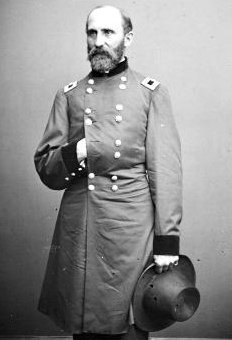Rufus Saxton facts for kids
Quick facts for kids
Rufus Saxton
|
|
|---|---|

Medal of Honor recipient
|
|
| Born | October 19, 1824 Greenfield, Massachusetts |
| Died | February 23, 1908 (aged 83) Washington, D.C. |
| Place of burial | |
| Allegiance | Union |
| Service/ |
United States Army Union Army |
| Years of service | 1849–1888 |
| Rank | |
| Battles/wars | American Civil War |
| Awards | Medal of Honor |
Rufus Saxton (October 19, 1824 – February 23, 1908) was an important Union Army officer during the American Civil War. He became a brigadier general and received the Medal of Honor. This is America's highest award for bravery in the military. He earned it for defending Harpers Ferry against Confederate forces. After the war, he helped lead the Freedmen's Bureau, an organization that assisted formerly enslaved people.
Contents
Early Life and Military Training
Rufus Saxton was born in Greenfield, Massachusetts. His father, Jonathan Ashley Saxton, believed in ending slavery and supported equal rights for women. He often gave speeches about these ideas.
Rufus Saxton went to the United States Military Academy at West Point. He graduated in 1849. Before the Civil War, he worked in different military jobs. He fought against Seminoles in Florida and taught soldiers about artillery. He also helped explore and map the Rocky Mountains for a new railroad.
Rufus Saxton married Mathilda Thompson, who was a missionary from Philadelphia. She moved South to teach newly freed African Americans. His brother, Will, also joined him in South Carolina to help with his work.
Service in the Civil War
When the Civil War began, Saxton became a quartermaster, which means he was in charge of supplies. He later became a brigadier general for the Union Army.
Defending Harpers Ferry
During the war, General Saxton commanded the Union defenses at Harpers Ferry. He showed great bravery there in May and June 1862. For his actions, he was awarded the Medal of Honor. At that time, very few generals had received this special award.
Helping Enslaved People
Later in 1862, Saxton was put in charge of supplying "contraband colonies" in South Carolina. These were places where formerly enslaved people lived, like on Edisto Island and at Port Royal. He was later made military governor of the Department of the South. In this role, he helped recruit the first regiments of black soldiers to fight for the Union Army.
After the War
After the Civil War ended, Saxton continued to serve in the Army. He worked in the U.S. Army Quartermaster Corps, still dealing with supplies.
He retired from the Army in 1888 as a colonel. He lived in Washington, D.C., until he passed away. He is honored with a memorial at Arlington National Cemetery.
Supporting African Americans
Rufus Saxton was a strong supporter of ending slavery and believed in equal rights for African Americans. His friend, author Thomas Wentworth Higginson, said that Saxton was one of the few students at West Point who felt strongly against slavery.
In 1866, Saxton spoke to Congress. He said that if African Americans were given all their rights as citizens, they would be peaceful and successful, just like anyone else.
Saxton appointed his friend, Thomas Wentworth Higginson, to lead the 1st South Carolina Volunteers. This was the first official black regiment in the Union Army. Saxton's work with these soldiers is mentioned in Higginson's book, Army Life in a Black Regiment. The formerly enslaved people even gave Saxton and Higginson special silver swords to thank them.
Honoring His Legacy
The Saxton School in Charleston, which was created to educate African Americans, was named after him. Also, Battery Barlow-Saxton at Fort MacArthur is named in his honor.

